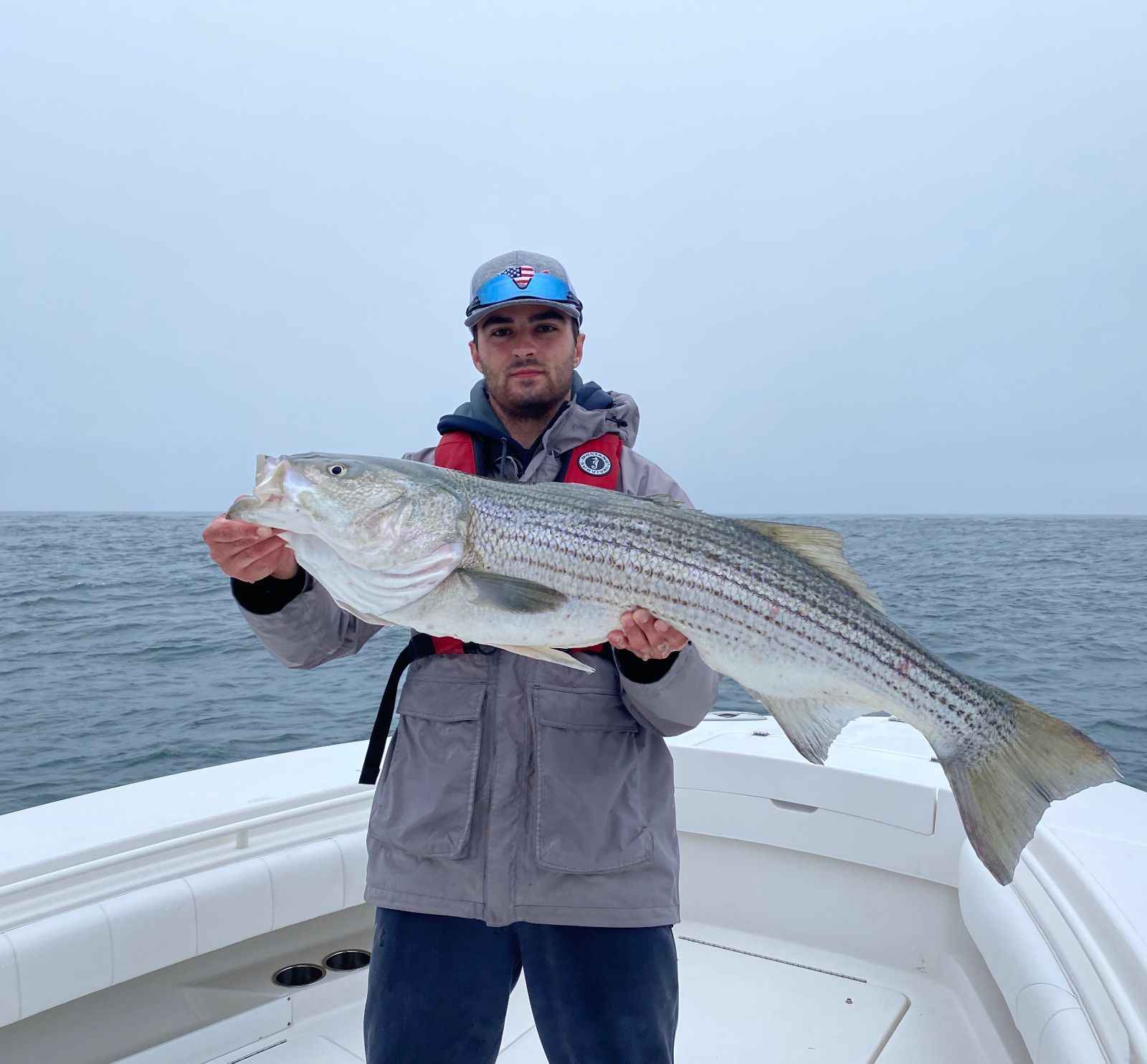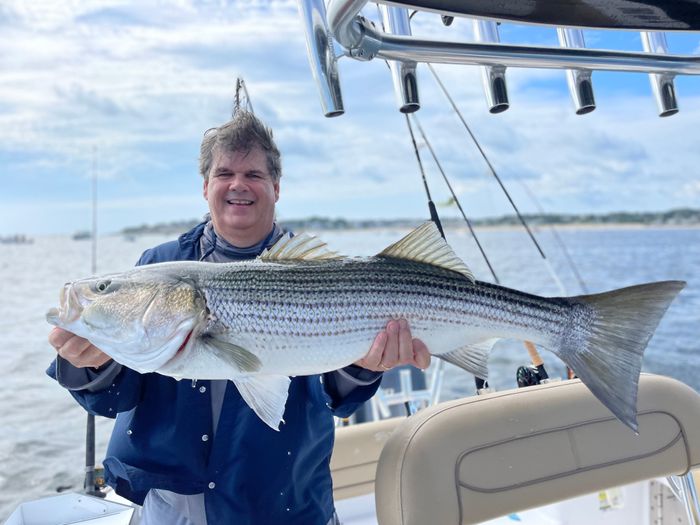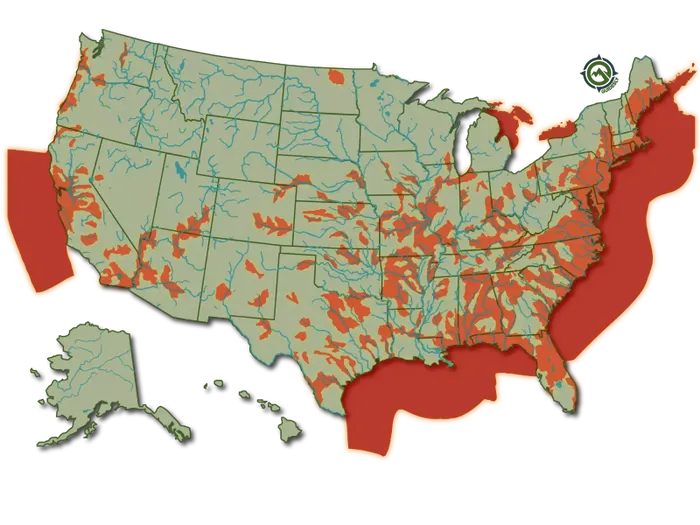The Striped Bass Migration (Complete Guide)
Learn the Striped Bass Migration Path. The striper migration up and down the east coast is a legendary fishing event.

Welcome aboard, fish fanatics! With the arrival of spring, the striped bass are on the move, and we're tagging along for the ride. From the shores of Florida to the rocky coasts of Maine, these magnificent fish are making their annual trek to their summer feeding grounds. In this post, we'll take you on a journey through the striped bass migration, exploring the routes they take, the obstacles they face, and the secrets behind their incredible journey. So grab your fishing gear, pack your sunscreen, and let's hit the water. It's time to follow these finned travelers and witness one of the greatest migrations in the animal kingdom.
What Is Striped Bass Migration?
The striper, otherwise known as the striped bass, is a true fish of the people. Native to the Atlantic Coast of North America, this highly migratory species gets around more than your neighborhood Casanova. Whether you're a fisherman looking to reel in a trophy catch, or just a fan of delicious seafood, the elusive striper is the fish for you. And don't let its name fool you - this striped beauty isn't just a one-trick pony. With a range that spans from Florida all the way up to Canada, this fish is as adaptable as it is tasty. So the next time you're at the seafood counter or out on the water, remember to give the striper some well-deserved respect. It's earned its stripes in more ways than one.

Striped bass are quite the travelers. They spend their lifetime going back and forth from their birthplace to the vast ocean for food and survival. Moreover, they do not shy away from a little seasonal change and migrate up and down rivers to find better feeding spots. It's almost as if they have an insatiable appetite as they journey across vast distances in search of the perfect meal. But let's not forget about their most important migration - the spawning run! Every spring, these striped beauties make their way back to their birthplace to lay their eggs and give rise to the next generation. So, let's salute these tireless travelers who continue to remind us that the journey is just as important as the destination.

Why Do Striped Bass Migrate?
Ah, the striped bass - a true migratory marvel! These fish know how to take advantage of their surroundings and move around like it's nobody's business. Why, in the springtime, they'll head north to warmer waters where they can spawn and munch on a ton of baitfish that just seem to be hanging around. And who can blame them? I mean, if you had the chance to feast on a buffet of delicious snacks, wouldn't you take it? The striped bass knows what's up and isn't afraid to make a move to get what it wants. So watch out, world - when the striped bass starts migrating, you best step aside and let it do its thing.
Every fall, the striped bass get ready to pack their bags and migrate south for the winter. And no, they're not just looking for warmer weather, even though we can all relate to that desire. They're actually seeking out sheltered areas where the water is cooler and there's less competition for food. You know, like a cozy Airbnb with a well-stocked fridge. By doing this, the striped bass ensure they have plenty of sustenance throughout the winter before beginning their journey back North in the spring. But let's not forget that the real reason for their migration is to spawn. It's like a romantic getaway, but for fish. So, if you spot a striped bass heading south this fall, give them a little wave and wish them luck on their winter vacation.
Meanwhile, the striper migration not only allows them to seek out the best breeding grounds and feeding grounds but also helps with their survival. The long-distance journey of striper migration serves as a natural defense mechanism against potential predators. Striped bass can be very sneaky and use their migratory patterns as camouflage, outsmarting predators who simply cannot match their endurance. This is just one of the many reasons why striped bass are so unique and amazing. As they travel through various bodies of water, they bring life and excitement wherever they go. It's no wonder why they are one of the most popular game fish, sought after by anglers from all over. So the next time you come across a striper, remember the incredible journey they've been on and give them the appreciation they deserve!

When Does Migration Take Place?
Every spring and fall, a wave of excitement sweeps fishermen as they eagerly await the arrival of the mighty striper. These fish are no couch potatoes; they're constantly on the move, their migration patterns dictated by the temperature of the water. In the spring, they migrate from the south to the north, following the warming waters. Then in the fall, they migrate back down south, following the cooling temperatures. And boy, do these fish know how to travel in style! They can swim up to 50 miles per day, making sure to stop at all their favorite spots along the way. So if you want to catch a striper, you better be ready for a wild ride because these fish are always on the go.
As the weather gets warmer, the striped bass embark on their annual migration to the freshwater rivers and streams of their spawning grounds. It's like they're ready for a little vacation from the ocean life and want to explore more inland destinations. It's a journey that can cover hundreds of miles and is filled with adventure and excitement. These fish are determined to reach their destination, even if it means overcoming obstacles along the way, such as dams or predators. But don't worry, these striped bass are no amateurs. Their strong instincts and impressive physical abilities make them great travelers. So, if you happen to live near a river or stream where these fish make their pit stop, be sure to grab your fishing gear and try your luck at catching one of these impressive creatures. Who knows, you might just end up with a fish story to tell for ages!
Besides being a wonder of nature, the striper migration serves as a reminder of the delicate balance between humans and the environment. These magnificent fish have survived the test of time and now depend on us to ensure their survival. Strict conservation measures have been put in place to protect the species and their habitats, but it's up to us to follow them. So next time you're out on your boat, fishing for stripers, remember to practice catch and release. Let's help these beauties continue their journey every year, from the cool waters of the north to the warm shores of the south. Until next fall, striper friends!

How Far Do Striped Bass Travel During Migration?
The striped bass is one adventurous fish! They don't just swim around a lake or river like the average trout; no, these guys take it to the next level with epic migrations. Imagine swimming up to 3,000 miles from their starting point in the Chesapeake Bay all the way to their wintering grounds near Canada. That's like swimming the length of the Great Wall of China, twice! It's no wonder they are known for their great endurance and stamina. It's like they're training for the aquatic Olympics or something. So, next time you're enjoying some delicious striped bass at dinner, remember that this fish has put in some serious mileage to get to your plate. Kudos to you, striped bass!
The Striped Bass Migration is truly an epic journey for these freshwater fish. It is the longest migration of any North American freshwater fish, spanning thousands of miles. To put it into perspective, it's more than twice as far as other migratory species like salmon and shad. These striped wonders are true road warriors, navigating their way through various bodies of water and overcoming obstacles along the way. It's like they're auditioning for The Amazing Race: Fish Edition. But unlike the reality show, this migration isn't just for fun and games. It's a matter of survival for these striped beauties, who need to spawn in certain areas to ensure the survival of their species. Hats off to the Striped Bass, the true MVPs of migratory fish.
Similarly, the remarkable migration patterns of the striped bass never cease to amaze marine biologists and anglers alike. These fish, commonly found in the coastal Atlantic waters, have proven to be highly adaptable to their environment, constantly adjusting their movement and feeding behaviors in response to changing weather and water conditions. With their ability to cover vast distances and traverse different water depths, it's no wonder that striped bass are highly sought after by fishermen looking for a challenge. Whether it's the thrill of the chase or the delicious taste of fresh seafood, one thing is for sure - the striped bass migration is a phenomenon worth watching and admiring. So next time you're out on the water, keep an eye out for these magnificent creatures and appreciate the incredible journey they undertake each year.
Where to Find Striped Bass?

The Impact of Water Temperature on Striped Bass?
The ideal temperature for striped bass to thrive in for most of the year is between 55 and 68-degrees Fahrenheit. However, they have been known to still be active and bite at temperatures ranging from 40 to 55 degrees Fahrenheit. Striped bass tend to become sluggish and are less likely to bite when the water temperature rises above 70 degrees Fahrenheit.
Given that the colder temperature tends to make striped bass and other species less active, it is reasonable to assume that deeper temperatures may also result in decreased activity levels due to the presence of cold water.
One can deduce that the behavior of striped bass is affected by sunlight, causing them to swim deeper and become less active. Hence, these conditions make this fish species an excellent catch during dawn and dusk. To ascertain their depths and behavior, the following methods can be utilized.
Striped bass tend to be more sluggish and are not as commonly captured when the temperature drops to 55° F and below. It is rare to catch striped bass in water that is below 44° F, and they can be found at depths ranging from 10 to 20 feet when in water at this temperature.
At temperatures between 55 and 58 degrees Fahrenheit, striped bass experience a boost of energy and become more lively. They can be found in depths of at least 10 feet.
Striped bass tend to thrive in water temperatures ranging from 55-68°F and typically occupy depths of 6 to 10 feet.
The Striped Bass: A Fish for All Seasons & Water Temperatures.
The Striped Bass is a versatile fish that can be enjoyed year-round, thanks to its adaptability to different temperatures and conditions. Whether it's summer or winter, this fish offers a range of culinary possibilities and can be prepared in many different ways. So don't limit your Striped Bass consumption to a specific season – embrace its versatility and enjoy it in all its forms!
As seasons change, striped bass adapt their behaviors and habitats. As an angler, you can take advantage of this by observing these changes and understanding the local fishing trends for the season you are fishing. This knowledge can lead to success on the water.
It's important to note that although we provide comprehensive information on striped bass, there may be specific factors unique to your local area that we haven't touched upon. Because of this, it's wise to consult with experienced local fishermen before setting out to catch this species in your region. Despite common knowledge about where and how to fish for striped bass, the insights of those who regularly fish in the area can be invaluable.
Spring
Spring is a season that occurs after winter and before summer. During this time, the weather tends to get warmer and plants begin to grow new leaves and flowers. It is often associated with new beginnings and a sense of renewal. Many people enjoy spending time outside during the spring, participating in activities such as hiking, picnicking, and gardening. Overall, spring is a time of change and growth.
To experience the thrill of catching spring striped bass, it's important to take into account their diet. As the environment transitions from winter to spring, various baitfish and nutritional sources will be seeking out warmer water. Joining in on their search can lead to a fun and successful fishing adventure.
Depending on where you are and how high up you are, the water temperature might be even colder. Nevertheless, by consulting the above diagram, we can determine the bass' level of activity. In order to find the right spots, look for shallow areas early in the day and then search deeper as the sun grows stronger.
Springtime provides an excellent opportunity to witness striped bass in their spawning process. As the temperature rises and spring enters full swing, the striped bass become more inclined to reproduce. When the temperature reaches a range of 65-68° F, it triggers their spawning instinct.
As the season changes, the coastal striped bass will make their way from the sea towards rivers, lagoons, and other accessible freshwater sources for their spawning period. Meanwhile, the landlocked striped bass and their hybrid counterparts will begin spawning earlier since their habitats warm up to the perfect temperature faster.
Summer
The season of warmth, sunshine and long days is known as summer. Summer is the time of year when the sun shines the brightest and the days are the longest. The season is known for its warmth, and people often spend their time outside enjoying the sunshine.
During the summertime, striped bass can be effectively caught in the early or late hours, as well as during deeper fishing expeditions throughout the day. If you take advantage of the tail end of spawning in early summer, there is potential for great catches. However, business as usual is expected throughout this period, and regular fishing tactics can easily yield success.
During the summer season, striped bass thrive in waters that maintain a temperature of approximately 68°F. These conditions are ideal for trolling in various water bodies including coastal waters, rivers, and lakes. It's important to note that when the sun is scorching, these fish will likely swim in deeper waters.
During the summer season, striped bass and other fish tend to be more active when it comes to feeding. This is because there is an abundance of food resources available. If you're looking to catch some fish, keep an eye out for groups of feeder fish and other locations where prey is abundant.
When it comes to fishing for landlocked striped bass in lakes, using bait is an effective and straightforward approach that adheres to the depth guidelines we previously discussed. Moreover, during this period, striped bass are highly energetic, providing an exhilarating battle to those who catch them. As such, the experience of catching them is all the more joyful.
Fall
After a busy summer season, fall brings on lowering temperatures and another change in striper fishing. As autumn sets in, we observe a decline in activity owing to the lowering water temperature. Nevertheless, in the majority of regions, the temperature stays higher than 55° F, ensuring that fishing remains robust.
Autumn presents a unique opportunity to witness a remarkable shift in surroundings and conduct in striped bass, especially in lakes and reservoirs. As the upper and lower layers of the water blend, due to differing temperatures, a water exchange takes place.
At the onset of winter, the water body first undergoes a temperature drop that inaugurates a series of events culminating in its chilling. The surface of rivers and landlocked waters show little indication of ice formation during fall, despite the colder atmosphere. The frigid waters also bless shallow waters with abundance at this time.
When fishing along the coast, it's wise to focus on shallow areas that are nearby cover or sand bars. To successfully catch fish, native anglers often navigate through rock formations and other obstructions. Fishing during the fall typically involves more cloudy days which can create less light and lead to more action in shallower waters.
Winter
Winter is the coldest season of the year, and it is characterized by shorter days and longer nights. The temperature drops significantly during winter, often causing snow and ice to form, making it harder to travel and stay warm. While some people enjoy winter activities like skiing and ice skating, others find winter to be a dreary and depressing time. Rewritten text: The coldest season of the year is winter, where the nights are longer and days are shorter. During this season, there is a significant drop in temperature that creates snow and ice, making it challenging to stay warm and travel. Winter sports like skiing and ice skating may be enjoyable for some, while for others, the melancholic and bleak periods can be a drag.
During the winter months, fishing can be challenging due to harsh and extreme temperatures. Inland bodies of water, such as lakes and ponds, freeze over while rivers may be partially or completely covered in ice. Despite these seemingly inhospitable conditions, the great striper fishing opportunities during this time make it all worth it.
Fishing deep with appropriate bait can yield favorable outcomes in both icy and coastal terrains. Optimal bait choice is contingent on observing the water for schools, with striped bass commonly attracted to herring, menhaden, mackerel, squid, and eels, among other options.
During winter, the temperature drops and causes the activity of striped bass to reduce significantly when it falls below 55° F. Areas with water temperature below 44° F may not have any stripers around, particularly inland regions where there's little water to cool compared to the east coast.
Winter offers a great opportunity to engage a tour guide or charter service in the vicinity where you plan to fish. As temperatures plunge and water conditions undergo a noticeable shift, seeking the guidance of a resident specialist could prove to be an excellent alternative to navigating the coastal waters unaided.
A Few Striped Bass Resources:
-Striped Bass Fishing, fishing tips, techniques, and best destinations
-Striped Bass Lures, expert guides weigh in with the best striped bass lures
-Striped Bass Bait, top 10 striped bass baits
-Striped Bass Cape Cod, expert guides discuss catching striped bass on Cape Cod
-Striped Bass Chesapeake Bay, expert guides discuss catching striped bass on Chesapeake Bay
-Striped Bass Fish, learn about the striped bass, habitat, fishing, migration, and more
Striper Feeding Patterns and Water Temperature
The feeding patterns and temperature preference of striped fish are complex. While warm water lacks the oxygen found in the deeper, colder water, the correlation between feeding activity and temperature is not straightforward. During winter when water surface temperatures are at their lowest, surface feeding is more frequent.
The optimal depth for feeding striped bass is between 15 and 20 feet, striking a balance between proximity to the surface and access to chilly, oxygenated water.
Contrary to popular belief, winter months and lower temperatures do not result in reduced feeding patterns of stripers. In fact, they continue to consume and flourish throughout the year, making them a catchable target even during winter.
It's common to desire a striped bass to bite your bait and leap out of the water, but it's possible for them to surprise you by feeding on lobsters and other sluggish bottom-roaming creatures, especially when they seek refuge in deep waters to escape the glaring sun and heat.
Is the Striper Spawning Process Influenced by Water Temperature?
The time for striper spawning begins in April and lasts until June, although sightings after June are not uncommon. The delay in their arrival may be attributed to the impact of climate change, which affects fish populations across the globe. During this time, striper migrate inland to spawn and require specific fishing techniques.
Throughout their regular season, stripers exhibit a certain pattern of behavior, but this changes entirely during their spawning period. Their conduct during mating season involves distinct and unusual actions like chasing each other around, thereby requiring a different approach to fishing.
The period of spawning in fish results in augmented hunger and susceptibility to bait or lures. Take advantage of this and catch the best fish during this time. Fly fishers will have a fruitful experience fishing in the shallow inlets and lagoons on the coasts.
You have the opportunity to catch fish as they enter the bays and inlets if you plan your trip accordingly, as is often the case with various inland-spawning species. This method is particularly effective if you're in a boat, allowing you to troll in a bay and mimic salmon fishing.




